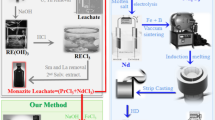Abstract
Spent pickling liquors pose a serious environmental problem in most industrialized countries, mainly owing to their corrosive properties and their ferrous iron and hydrochloric acid content. In this paper, spent pickling liquor was used as an inexpensive raw material to prepare Fe3O4 magnetic powder via an oxidation method. Being able to recover the dissolved iron from spent pickling liquors would not only salvage a valuable material but also render the effluent environmentally benign. The structure of the Fe3O4 magnetic powder was characterized by X-ray diffraction. The morphology and size were characterized by scanning electron microscopy and transmission electron microscopy. Their magnetic properties were tested at room temperature by a vibrating sample magnetometer. In addition, the saturation magnetization of Fe3O4 products can be further enhanced to 96.1 emu/g after purification.







Similar content being viewed by others
References
Tang B, Yuan LJ, Shi TH et al (2009) Preparation of nano-sized magnetic particles from spent pickling liquors by ultrasonic-assisted chemical co-precipitation. J Hazard Mater 163(2–3):1173–1178
Devi A, Singhal A, Gupta R et al (2014) A study on treatment methods of spent pickling liquor generated by pickling process of steel. Clean Technol Environ 16(8):1515–1527
Konishi YS, Nomura T, Mizoe K (2004) A new synthesis route from spent sulfuric acid pickling solution to ferrite nanoparticles. Hydrometallurgy 74(1–2):57–65
López-Delgado A, Alguacil FJ, López FA (1997) Recovery of iron from bio-oxidized sulphuric pickling waste water by precipitation as basic sulphates. Hydrometallurgy 45(1–2):97–98
Lewis DJ, Tye FL (2007) Treatment of spent pickle liquors by electrodialysis. J Anal Chem 9(5):279–292
Paquay E, Clarinval AM, Delvaux A et al (2000) Applications of electrodialysis for acid pickling wastewater treatment. Chem Eng J 79(3):197–201
Tomaszewska M, Gryta M, Morawski AW (2001) Recovery of hydrochloric acid from metal pickling solutions by membrane distillation. Sep Purif Technol 22–3(1–3):591–600
Csicsovszki G, Kekesi T, Torok TI (2005) Selective recovery of Zn and Fe from spent pickling solutions by the combination of anion exchange and membrane electrowinning techniques. Hydrometallurgy 77(1–2):19–28
Ciminelli VST, Dias A, Braga HC (2006) Simultaneous production of impurity-free water and magnetite from steel pickling liquors by microwave-hydrothermal processing. Hydrometallurgy 84(1–2):37–42
Guskos N, Papadopoulos GJ, Likodimos V et al (2002) Photoacoustic, EPR and electrical conductivity investigations of three synthetic mineral pigments: hematite, goethite and magnetite. Mater Res Bull 37(6):1051–1061
Wei XC, Viadero RC (2007) Synthesis of magnetite nanoparticles with ferric iron recovered from acid mine drainage: implications for environmental engineering. Colloid Surface A 294(1–3):280–286
Cornell RM, Schwertmann U (1996) The iron oxides: structure, properties, reactions, occurrences and uses. Clay Miner 61(408):740–741
Teja AS, Koh PY (2009) Synthesis, properties, and applications of magnetic iron oxide nanoparticles. Prog Cryst Growth Charact Mater 55(1–2):22–45
Iida H, Takayanagi K, Nakanishi T et al (2007) Synthesis of Fe3O4 nanoparticles with various sizes and magnetic properties 14 by controlled hydrolysis. J Colloid Interf Sci 314(1):274–280
Kulkarni SA, Sawadh PS, Palei PK et al (2013) Effect of synthesis route on the structural, optical and magnetic properties of Fe3O4 nanoparticles. Ceram Int 40(1):1945–1949
Yang JH, Zou P, Yang LL et al (2014) A comprehensive study on the synthesis and paramagnetic properties of PEG-coated Fe3O4 nanoparticles. Appl Surf Sci 303:425–432
Fan R, Chen XH, Gui Z et al (2001) A new simple hydrothermal preparation of nanocrystalline magnetite Fe3O4. Mater Res Bull 36(3–4):497–502
Lu T, Wang JH, Jie Yin et al (2013) Surfactant effects on the microstructures of Fe3O4 nanoparticles synthesized by microemulsion method. Colloid Surface A 436(35):657–683
Xu J, Yang HB, Fu WY et al (2007) Preparation and magnetic properties of magnetite nanoparticles by sol-gel method. J Magn Magn Mater 309(2):307–311
Lemine OM, Omri K, Zhang B et al (2012) Sol-gel synthesis of 8 nm magnetite (Fe3O4) nanoparticles and their magnetic properties. Superlattice Microst 52(4):793–799
Abdel-Ghany AE, Mauger A, Groult H et al (2012) Structural properties and electrochemistry of alpha-LiFeO2. J Power Sources 197:285–291
Shen LZ, Qiao YS, Guo Y et al (2013) Preparation and formation mechanism of nano-iron oxide black pigment from blast furnace flue dust. Ceram Int 39(1):737–744
Misawa T, Hashimoto K, Shimodaira S (1974) Chemlnform abstract: the mechanism of formation of iron oxide and oxyhydroxides in aqueous solutions at room temperature. Corros Sci 14(2):131–149
Neger AT, Ahmed A, Parvin S et al (2009) Studies on black iron oxide pigment. Part-II: effect of preparation parameter on particle size and microstructure of ferrosoferric oxide. Bangladesh J Sci Ind Res 44(1):31–40
Hong RY, Pan TT, Han YP et al (2007) Magnetic field synthesis of Fe3O4 nanoparticles used as a precursor of ferrofluids. J Magn Magn Mater 310(1):37–47
Acknowledgements
This work was supported by the project of Synthesis of Iron Oxide Red from Waste Acid (No. 2016GIF-0035).We wish to thank Mr. Lin Kui and Mr. Zhou Dingbang, Tianjin University, Tianjin, China, for their assistance in characterizing the Fe3O4 magnetic powder.
Author information
Authors and Affiliations
Corresponding author
Rights and permissions
About this article
Cite this article
Wang, X., Lv, F. Synthesis of Fe3O4 Magnetic Powder from Spent Pickling Liquors. Trans. Tianjin Univ. 24, 45–50 (2018). https://doi.org/10.1007/s12209-017-0095-5
Received:
Revised:
Accepted:
Published:
Issue Date:
DOI: https://doi.org/10.1007/s12209-017-0095-5




